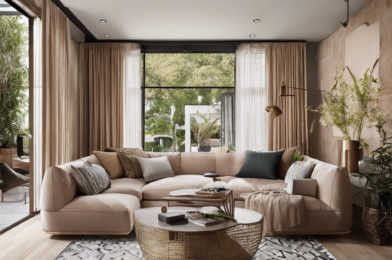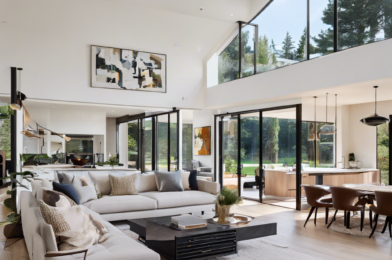The world of upcycling is a magical place where old, tired furniture is transformed into unique and stunning statement pieces. With a bit of creativity and elbow grease, that worn-out dresser can become a masterpiece that takes center stage in your home. Upcycling is an innovative and sustainable way to refresh your space, and it’s a trend that’s captivating the hearts of many.
There is something truly special about taking an old, neglected piece of furniture and giving it new life. Upcycling allows you to imbue your unique sense of style and personality into every corner of your home. By rescuing and repurposing, you’re not just creating beautiful décor, but also crafting stories and memories that will endure for years to come.
The art of upcycling lies in its ability to blend functionality with aesthetics. It’s about seeing the potential in a piece that others might overlook and envisioning how it can be adapted to serve a new purpose. That old cabinet, with a little creativity, can become a one-of-a-kind kitchen island, or that worn-down table can be transformed into a vibrant desk with a fresh coat of paint and some stylish new hardware.
For those with a penchant for all things DIY, upcycling offers an exciting opportunity to flex their creative muscles. It’s a process that encourages experimentation and embraces imperfections, resulting in pieces that are truly one-of-a-kind. Whether it’s a simple paint job or a complete furniture overhaul, the journey of transforming a discarded item into a cherished possession is immensely rewarding.
One of the biggest appeals of upcycling is its sustainability. In a world increasingly conscious of waste and environmental impact, upcycling offers a responsible and eco-friendly approach to furnishing your space. By rescuing and repurposing old furniture, you’re reducing landfill waste, preserving natural resources, and minimizing the demand for new, resource-intensive productions.
Upcycling also holds a certain nostalgic charm. It allows us to reconnect with the past and preserve a piece of history. That vintage sideboard or antique chair carries with it stories and memories of its previous life. By restoring and repurposing these pieces, we’re not just giving them a new lease of life, but also honoring the craftsmanship and heritage they represent.
The upcycling community is a thriving and supportive network of creators who embrace the exchange of ideas and inspiration. Whether it’s through online platforms, local workshops, or flea markets, upcyclers find joy in sharing their projects, techniques, and unique twists. This sense of community fosters a culture of collaboration and encouragement, making the journey of transforming furniture that much more enjoyable.
For those just dipping their toes into the world of upcycling, the array of possibilities can be overwhelming. The key is to start small and simple. Assess the piece of furniture you want to work on and consider its potential for transformation. A fresh coat of paint in a bold color or an on-trend pattern can instantly update a dull piece, or you could try your hand at reupholstering a vintage chair with a funky new fabric.
When it comes to upcycling, the possibilities are endless. You can let your imagination run wild and experiment with different styles, techniques, and materials. From decoupage to distressing, from adding embellishments to creating mixed-media masterpieces, the only limit is your creativity. Embrace the unexpected and you’ll soon discover the magic of upcycling.
While upcycling can be a fun and rewarding hobby, it’s also a practical way to furnish your home on a budget. By rescuing and repurposing old furniture, you can create high-end looks for a fraction of the cost. With a bit of elbow grease and some careful planning, you can achieve stunning results that rivals expensive designer pieces.
Upcycling also allows you to embrace individuality and curate a home that truly reflects your personality. Mass-produced furniture may be convenient, but it often lacks the character and uniqueness that comes with a handmade, upcycled piece. By embracing the imperfections and celebrating the story behind each transformation, you’re infusing your space with a sense of warmth and individuality.
The beauty of upcycling extends beyond the transformation of furniture. It’s a mindset that can be applied to various aspects of our lives. Upcycling encourages us to be resourceful and open-minded, to see potential where others see waste, and to embrace sustainability in our daily choices. It’s a reminder that with a little creativity, we can make a positive impact on our surroundings and the planet.
The satisfaction that comes from transforming something old into something new is indescribable. There’s a sense of pride and accomplishment in knowing that you’ve created something unique and given it a second chance. Whether it’s the thrill of the hunt for the perfect piece to transform or the joy of unveiling the finished product, upcycling is a journey that feeds the soul and sparks joy.
Upcycling has become a cultural phenomenon, with its own dedicated magazines, television shows, and social media platforms. It has inspired a new generation of creators who embrace sustainability and individuality in their homes and lifestyles. By sharing their upcycling journeys and transformations, they’re encouraging others to embrace the magic of transformation and discover the beauty in second chances.
Whether you’re an experienced upcycler or just starting, there’s always something new to learn and discover. Each piece of furniture presents a unique set of challenges and opportunities for creativity. Embrace the process, be open to experimentation, and above all, have fun. The journey of upcycling is just as important as the final transformation.
So, the next time you’re considering refreshing your space or seeking that perfect statement piece, why not try your hand at upcycling? With a bit of imagination and elbow grease, you too can create magic and transform old furniture into stunning conversation starters. Embrace the journey, and who knows, you might just fall in love with the process and the endless possibilities it holds. Happy upcycling!









